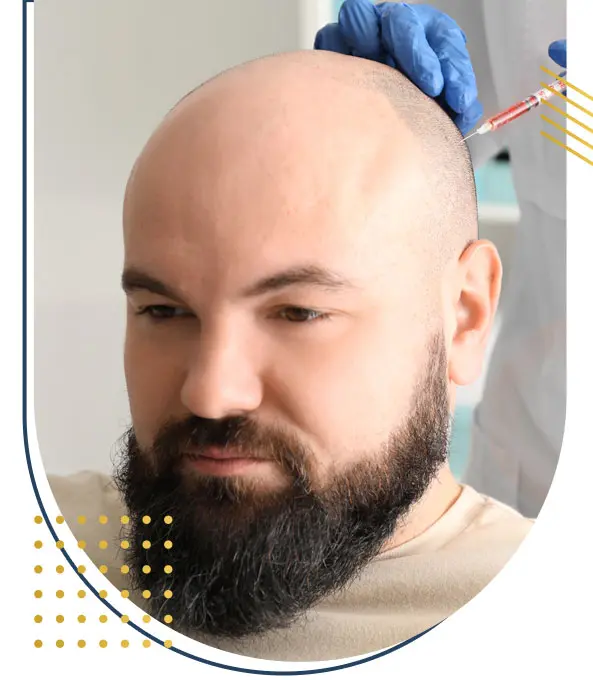
A person’s hair represents an important aspect in one’s appearance. It can totally change the look of an individual and plays a big part in self-confidence. Both physically and psychologically, Hair loss can be a great dilemma for most people.
To treat such situations, Hair Transplant surgeries are becoming increasingly performed and might be, in some cases, a definitive solution to hair loss issues.
Definition Hair transplant in Egypt
A hair transplant is a surgical procedure that has an aesthetic purpose. It consists in the transfer of hair to a balding place in the head. This practice saw its first success with the Dr. Norman Orentreich in 1952. Since then, technological and scientific advancements brought new techniques that are more accurate and successful.
Types of Hair transplant in Egypt
Hair transplant is a procedure that is performed with different techniques, each their uses with almost the same result. Depending on the situation and the area to cover, the surgeons make the appropriate decision.
Basically, there are three major methods used in Hair Transplant :
- FUT
- FUE
- DHI
What is FUT Hair Transplant in Egypt ?
The FUT or Follicular Unit Transplant, Is a very known surgery that treats issue of hair loss. It consists in cutting a stripe from the side or the back of the head before extracting the hair follicles and inserting it in the receiving area.
This procedure is becoming less common due to the postoperative effects and scars it leaves.

What is FUE Hair Transplant in Egypt ?
The FUE Technique or Follicular Unit Extraction is one of the most common practices in the field of Hair Transplant. It consists in the removal of hair follicles individually directly from one part of the head and plant it in the balding area.
Its popularity has grown over time compared to its predecessor, the FUT technique, for the natural looking results it gives and the lack of visible postoperative scars.
What is DHI Hair Transplant in Egypt ?
The DHI or Direct Hair Implantation is an innovative and the most advanced technique to treat hair loss problems. This approached was developed by the DHI Global Medical Group Company, inspired from the FUE technique.
This method consists in the same approach as the FUE, which is extracting the hair follicle directly, and manually, from the donor area, but in the DHI, the surgeon will be using a special pen. This innovative technological tool allows the extraction and implantation of the hair follicles, with great precision and almost invisible postoperative scars.
What are the secondary types of hair transplant ?
Robotic Hair Transplantation (RHT) :
Picture this: a futuristic scene where precision meets automation in the realm of hair restoration. Robotic Hair Transplantation (RHT) is a cutting-edge approach that combines advanced robotics with the artistry of hair transplantation.
Imagine a robotic arm delicately extracting individual hair follicles with unparalleled accuracy, guided by sophisticated algorithms programmed to select the healthiest grafts for transplantation.
This method offers several advantages, including minimal scarring, precise graft extraction, and reduced procedure time. Patients can expect natural-looking results with minimal downtime, thanks to the precision of robotic technology. RHT represents the epitome of innovation in the field of hair transplantation, blending human expertise with the efficiency of machines to deliver outstanding outcomes for those seeking to reclaim their crowning glory.
Long-Hair Transplantation :
In the realm of hair transplantation, long-hair transplantation emerges as a distinctive approach tailored to meet the aesthetic preferences of patients desiring immediate visual impact post-procedure.
Unlike traditional methods where the donor hair is trimmed short before extraction, long-hair transplantation preserves the length of the donor hair, allowing for seamless blending with existing hair upon transplantation.
Picture the transformation: long strands of hair seamlessly integrated into the recipient area, creating a natural and voluminous appearance from the get-go. This technique not only offers instant gratification but also eliminates the awkward phase of waiting for newly transplanted hair to grow out, providing patients with a confidence boost from the moment they walk out of the clinic.
Long-hair transplantation represents a harmonious fusion of artistry and innovation, catering to the aesthetic aspirations of individuals seeking a swift and stunning hair restoration journey.
Sapphire FUE :
Enter the realm of Sapphire FUE, where precision meets sophistication in the quest for flawless hair restoration.
Sapphire FUE is a refinement of the traditional Follicular Unit Extraction (FUE) technique, distinguished by the use of sapphire blades for creating recipient sites with unparalleled precision and finesse. Imagine a gemstone-infused blade gliding effortlessly across the scalp, creating tiny incisions with unmatched accuracy, resulting in minimal trauma to the surrounding tissue and faster healing times.
The use of sapphire blades not only ensures a smoother transplantation process but also reduces the risk of complications such as follicular damage and scarring.
Patients can expect superior aesthetic outcomes with Sapphire FUE, characterized by natural-looking hairlines and denser coverage, thanks to the precision and gentleness of this advanced technique. Sapphire FUE epitomizes the marriage of innovation and artistry, offering patients a path to hair restoration excellence with unmatched precision and finesse.
ARTAS Hair Transplant :
Step into the realm of robotic precision with ARTAS Hair Transplant, where state-of-the-art technology meets the artistry of hair restoration.
ARTAS represents a paradigm shift in the field of hair transplantation, harnessing the power of robotic automation to enhance the precision, consistency, and efficiency of follicular unit extraction. Picture a robotic arm meticulously identifying and harvesting individual hair follicles from the donor area with unparalleled accuracy, guided by advanced algorithms designed to select the healthiest grafts for transplantation.
This method offers several advantages, including reduced procedure time, minimal scarring, and precise graft placement, resulting in natural-looking outcomes that exceed patient expectations. With ARTAS Hair Transplant, patients can embark on a journey to reclaim their confidence with minimal discomfort and downtime, thanks to the seamless integration of robotic technology into the hair restoration process. ARTAS represents the pinnacle of innovation in the field of hair transplantation, offering patients a transformative experience that blends cutting-edge technology with the artistry of hair restoration.
How to prepare for a Hair Transplant procedure ?
Pre-Procedure Consultation :
Before embarking on the journey of hair restoration, it's essential to undergo a thorough pre-procedure consultation with a qualified and experienced hair transplant surgeon.
During this consultation, the surgeon will assess your medical history, evaluate the extent of your hair loss, discuss your aesthetic goals, and determine the most suitable hair transplant technique for your individual needs.
This consultation serves as an opportunity for you to ask questions, express any concerns, and gain a clear understanding of the procedure, including potential risks and expected outcomes.
The surgeon will also provide detailed instructions on pre-operative preparations, including dietary guidelines, medications to avoid, and lifestyle modifications to ensure optimal healing and recovery post-procedure.
Medical Evaluation :
In preparation for a hair transplant procedure, it's crucial to undergo a comprehensive medical evaluation to assess your overall health and identify any underlying medical conditions that may impact the surgery or your ability to heal properly.
This evaluation may include routine blood tests, imaging studies, and consultations with other specialists if necessary.
The goal is to ensure that you are in good physical condition to undergo surgery and that any pre-existing medical issues are properly managed to minimize the risk of complications during or after the procedure.
Your hair transplant surgeon will work closely with your primary care physician or specialists to coordinate your care and optimize your safety throughout the surgical process.
Medication Adjustment :
In the days leading up to your hair transplant procedure, your surgeon may recommend adjustments to your current medications to minimize the risk of complications and promote optimal healing. This may involve temporarily discontinuing certain medications that can interfere with blood clotting or increase the risk of excessive bleeding during surgery.
Additionally, if you are taking medications that may affect hair growth or interact with anesthesia, your surgeon will provide guidance on how to manage them before and after the procedure.
It's essential to follow your surgeon's instructions closely and communicate any concerns or questions you may have about your medications to ensure a smooth and successful surgical experience.
Scalp Preparation :
On the day of your hair transplant procedure, proper scalp preparation is crucial to ensure optimal conditions for surgery and maximize the viability of transplanted hair follicles.
Your surgeon will provide specific instructions on how to prepare your scalp, which may include washing your hair with a gentle shampoo to remove any dirt, oil, or styling products that could interfere with the surgical process.
It's important to avoid using hair products such as gels, waxes, or hairsprays in the days leading up to the procedure to ensure a clean and healthy scalp environment.
Additionally, your surgeon may recommend avoiding alcohol-based products that can dry out the scalp and increase the risk of irritation or infection. Following these scalp preparation guidelines will help create an ideal foundation for a successful hair transplant surgery and promote optimal healing and recovery afterward.
Emotional Preparation :
In addition to physical preparations, it's essential to prepare emotionally for the hair transplant procedure and set realistic expectations for the results. Hair loss can have a significant impact on self-esteem and body image, and undergoing a hair transplant can be an emotional journey for many individuals.
It's normal to feel anxious or apprehensive about the surgery, but it's important to remember that you are taking a proactive step towards restoring your confidence and reclaiming your appearance. Surround yourself with supportive friends and family members, seek guidance from your surgeon or mental health professional if needed, and focus on the positive aspects of the upcoming procedure, such as the opportunity to achieve natural-looking results and improve your quality of life.
By preparing emotionally and mentally for the hair transplant journey, you can approach the procedure with confidence, resilience, and optimism, setting the stage for a successful outcome and a brighter future ahead.
Nutritional Preparation :
Optimal nutrition plays a vital role in supporting the body's healing process and promoting hair growth.
In the weeks leading up to your hair transplant surgery, it's essential to focus on a balanced diet rich in vitamins, minerals, and protein to nourish your scalp and hair follicles.
Incorporate foods high in protein, such as lean meats, fish, eggs, and legumes, to provide the building blocks for healthy hair growth. Additionally, consume plenty of fruits, vegetables, and whole grains to ensure adequate intake of vitamins and minerals essential for hair health, such as vitamin C, vitamin E, zinc, and biotin. Consider incorporating supplements into your diet, such as biotin or omega-3 fatty acids, under the guidance of your healthcare provider. Hydration is also key, so be sure to drink plenty of water to keep your scalp and body hydrated. By fueling your body with the nutrients it needs, you can optimize the healing process and enhance the results of your hair transplant procedure.
Smoking Cessation :
If you're a smoker, now is the perfect time to kick the habit in preparation for your hair transplant surgery. Smoking not only compromises the body's ability to heal effectively but also constricts blood vessels, reducing blood flow to the scalp and potentially affecting the survival of transplanted hair follicles.
By quitting smoking several weeks before your procedure, you can improve blood circulation, reduce the risk of complications such as infection and delayed healing, and enhance the overall success of your hair transplant surgery.
Seek support from friends, family, or healthcare professionals to help you quit smoking, and explore strategies such as nicotine replacement therapy or counseling to increase your chances of success. Your decision to quit smoking not only benefits your hair transplant journey but also improves your overall health and well-being in the long run.
Financial Planning :
Hair transplant surgery is an investment in your appearance and self-confidence, and it's essential to plan financially for the procedure and associated costs.
In addition to the cost of the surgery itself, consider expenses such as pre-operative consultations, medical tests, post-operative medications, and any follow-up appointments or touch-up procedures that may be necessary. Research different financing options, such as payment plans or medical financing companies, to determine the best approach for managing the cost of your hair transplant surgery.
Additionally, check with your health insurance provider to see if any aspects of the procedure are covered under your plan. By planning ahead and budgeting for the expenses associated with your hair transplant surgery, you can approach the procedure with peace of mind and focus on achieving the best possible results without financial stress.
The Procedure of Hair Transplant in Egypt :
Depending on which technique is used during the surgery, the doctor prepares the patient by marking the donor and receiving areas. After that, local anaesthesia is done through a tiny needle. In most cases, the surgeon applies small repetitive pressure with his fingers to widen the effect area of the anesthetics.
In case the FUT technique is used, the surgeon will proceed by cutting a skin stripe from the scalp on the back or the side of the head. This is done using a sharp scalpel. Generally, the stripe is around 1.5 centimeters long. After that, the incision is sutured.
The surgeon will manipulate the sections removed by separating them with surgical tools before starting the extraction of hair follicles.
Finally, the doctor performs the implantation of the hair follicle in the target areas. The extraction and implanting process is done using a magnifying lens.
In the FUE Technique, the Surgeon starts by cleaning the head before starting to perform tiny cuts and incisions in the patient’s scalp to extract directly the hair follicles.
After that, numerous holes are made by a needle or a blade in which the surgeon will insert several hundreds of the extracted follicles.
Using the DHI technique, the Surgeon will use the special pen tool on the donor area to extract individually the hair follicles from that site. He then proceeds to the implantation of those follicles in the balding area, using the same tool that has loaded them

Difference between FUT / FUE / DHI :
The most obvious difference between the three techniques is in the method used and the postoperative effects. For instance, the FUT is one that takes around four hours but it leaves scars after the operation. Especially if the hair is short, it will be visible.
The FUE and DHI differ in the application method used on the patient. One uses a scalpel, and the other one uses a special pen tool. The converging points are the length of the operation and the small number of postoperative scars. Usually, these techniques take up to eight hours to finish.
Depending on what you are looking for, you can make the choice of having a Hair Transplant in Egypt using these techniques. The surgeon will give you the best option for the optimal results.
What to expect after a Hair Transplant in Egypt ?
After a hair transplant, you will notice some strange reactions like falling hair in the treated area. That is totally normal. Planted hair loss will happen during the first sixty days after the operation. It might take some time, up to four months, for the hair follicle to adjust and the area to totally recover.
What is the price of a hair transplant in Egypt ?
The price hair transplant Egypt is interesting, ask for a free online quote to obtain hair transplant cost Egypt.
If you need more information, you can contact us by phone on the phone numbers you will find on our website.

